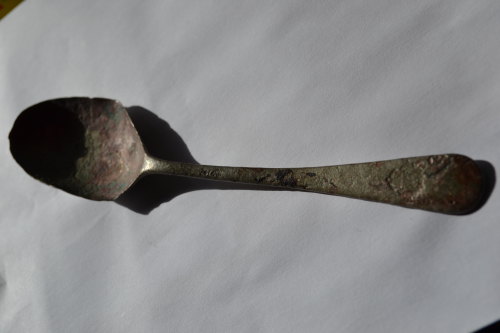
Image use policy
Our images can be used under a CC BY attribution licence (unless stated otherwise).
SPOON
Unique ID: MAS-100007
Object type certainty: Certain
Workflow
status: Published ![]()
This spoon is made of a metal alloy, possibly copper alloy, and was probably originally plated. Its manufacture would have been cast. The Royal Australian Air Force (RAAF) crest is stamped into the end of the spoon. The crest features the RAAF monogram with a laurel wreath surmounted by a crown. This crest is the same style as that used for cap badges and is modelled from a Royal Air Force (RAF) crest.
The more widely adopted RAAF crest was commissioned and designed in 1937 and accepted in 1939. It is composed of the imperial crown mounted on a circle featuring the words 'Royal Australian Air Force' and overlaid with a wedge-tailed eagle. Beneath this the scroll work displays the Latin motto 'Per Ardua Ad Astra' (through adversity to the stars).
This spoon may have been issued by the RAAF victualling department for squadron members to use in the mess, or to a particular individual as one item of their personal mess gear accompanied by crockery and other cutlery. It was the Australian Defence Force that adopted the cutlery moniker 'eating irons'.
The spoon was discovered on Batten Beach, Plymouth, which is in proximity to RAF Mount Batten, a RAF station and flying boat base, and indicates the likely origin and time period of its loss, although it may have been produced any time after 1921, when the RAAF was formed.
Notes:
The RAF Station Mount Batten was used as a base for flying boats to defend south-west England since 1 October 1928. The start of the Second World War (WW2) saw an increase in operational flying from the base and it was also targeted during German air raids. Two Australian squadrons were under RAF operation control at Mount Batten during WW2: No 461 and No 10 Squadron, both flying the Short Sunderland.
No 461 Squadron was formed at RAF Mount Batten on 25 April 1942 as an anti-submarine squadron and was stationed there until 31 August 1942. It was disbanded on 4 June 1945, having destroyed six German U-boats. Sixty-four of the 86 squadron members killed were Australian.
No 10 Squadron was formed on 1 July 1939 and was the first RAAF and British Commonwealth squadron to see active service in WW2. Running anti-submarine operations and patrols, No 10 Squadron operated mainly from bases in southern Britain. It took over the base at Mount Batten in April 1940, however moved to Pembroke in May 1941. No 10 Squadron returned to Mount Batten in January 1942 and remained stationed there until it was disbanded on 26 October 1945, and left for Australia. The squadron sank six U-boats and lost 161 personnel during WW2.
The NRHE and City of Plymouth HER reference numbers cited in this record refer to the base at Mount Batten.
Class:
Food preparation and consumption
Sub class: Cutlery
Subsequent actions
Current location of find: With finder
Subsequent action after recording: Submitted as wreck to the Receiver of Wreck
Wreck details
Droit number: 382/16
Chronology
Broad period: MODERN
Period from: MODERN
Period to: MODERN
Date from: Circa AD 1940
Date to: Circa AD 1945
Dimensions and weight
Quantity: 1
Discovery dates
Date(s) of discovery: Monday 25th July 2016
Personal details
Found by: This information is restricted for your login.
Recorded by: M F
Identified by: V L
Secondary identifier: L M
Other reference numbers
NRHE monument number: 1200528
Other reference: City of Plymouth HER Number: SX 45 SE 589
Droit ID: 382/16
Materials and construction
Primary material: Copper alloy
Manufacture method: Cast
Completeness: Complete
Surface Treatment: Plated
Spatial coordinates
4 Figure: SX4853
Four figure Latitude: 50.35723329
Four figure longitude: -4.13817474
1:25K map: SX4853
1:10K map: SX43SE
Display four figure position on What3Words
Grid reference source: From finder
Unmasked grid reference accurate to a 1 metre square.
References cited
No references cited so far.
Similar objects

Find number: MAS-100012
Object type: LANDING CRAFT INFANTRY
Broadperiod: MODERN
This hulk is situated on the River Deben, just outside of Melton (Suffolk) and is estimated to measure 11.5 m in length and 3 m in width. The …
Workflow: Published![]()

Find number: MAS-D100191
Object type: COIN
Broadperiod: NINETEENTH CENTURY
This find comprises of a single gold coin from the USA with a value of $10. This 1847 minted coin was created for standard circulation and mea…
Workflow: Published![]()

Find number: MAS-D100180
Object type: CANNON
Broadperiod: POST MEDIEVAL
This item appears to be a small calibre black powder weapon, such as a swivel gun, commonly mounted on vessels throughout the age of sail as w…
Workflow: Published![]()



